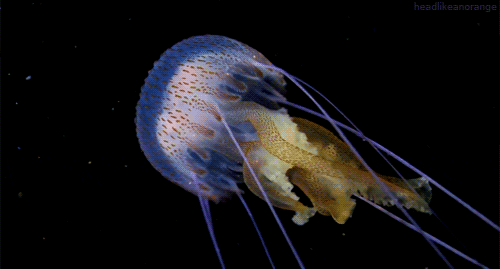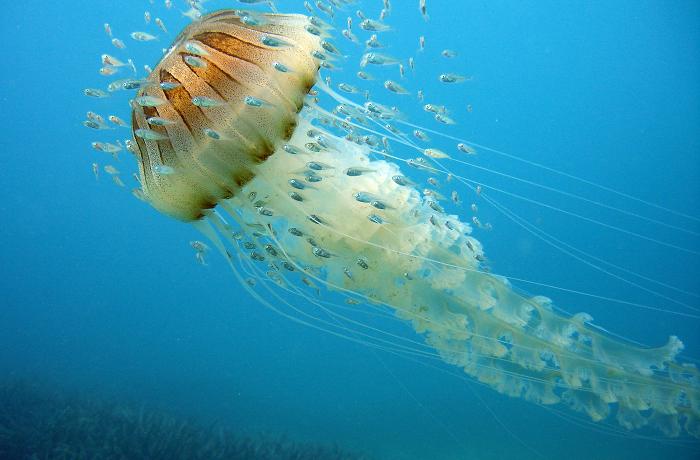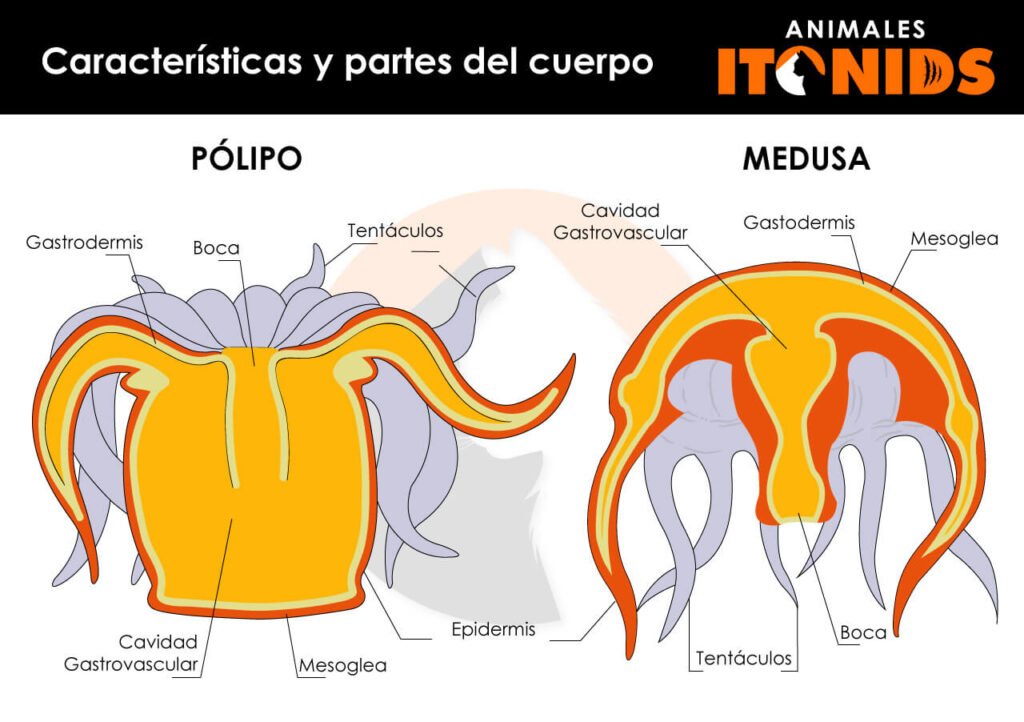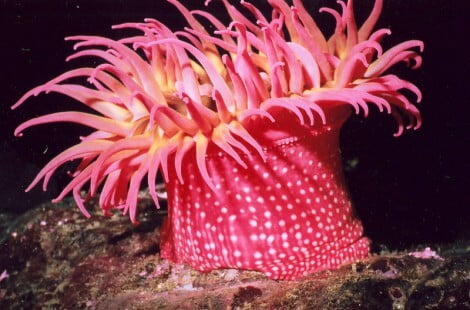When it comes to grandiose and mysterious places, the sea (and its depths) holds a privileged position, with incredible species and unique characteristics.
Jellyfish, corals, and other unique animals are examples of this, belonging to the group known as cnidarians (or coelenterates), inhabiting our planet for about 700 million years.
Today, it is possible to find more than 9,000 exclusively aquatic species, and many more await discovery, as it is estimated that only about 5% of the oceans have been explored – just imagine!
Want to know more? Discover the main characteristics of cnidarians and why they are considered so important for the planet.
What are Cnidarians?
Also called coelenterates, they are a group of invertebrate animals (they do not have a backbone), of gelatinous consistency and variable size, presenting radial symmetry, that is, from a central axis (the mouth), the body can be divided into equal parts.
Their name arises from two Greek words: “koilos” meaning hollow, and “énteron”, intestine; giving rise to the word “coelenterate” or “hollow intestine”, named so because they have a single orifice that functions as both mouth and anus.
This group includes polyps, jellyfish, sea anemones, corals, and hydras.
Where do they live?
Cnidarians are aquatic and almost all species live in the sea, from warm waters to the Arctic (North Pole), in shallow tidal zones or dark depths; only a few inhabit freshwater, like rivers or lakes (genus Hydra).
They can live in colonies (large communities), like coral reefs, or be solitary, anchored on the ocean floor or moving with the water currents.
Characteristics of Cnidarians They do not have a skeleton, head, or brain.
They are composed of water (95%), and commonly have the shape of a column (corals), bag (polyps), or umbrella (jellyfish).
They possess circular or radial symmetry (similar to the spokes of a bicycle wheel) that starts from a central point (the mouth) and distributes the body symmetrically.
Their size varies from a few millimeters to several meters (in the case of giant jellyfish).
Their body is formed by two layers: an outer layer (epidermis) responsible for protection and interaction with the environment, and an inner layer (gastrodermis), whose main function is digestive, separated by a gelatinous tissue (mesoglea).
They have light receptors (eyespots, ocelli), formed by a group of cells that allow them to distinguish light and shadows. The jellyfish possesses a sensory structure (rhopalium) with complex eyes that may contain a cornea, lenses, and retina!

They have a single opening, called the stomodeum, which serves both as a mouth and an anus; and connects the exterior to an internal cavity that functions as a digestive system (coelenteron).
Their mouth is surrounded by tentacles (in multiples of six or eight) whose size varies according to the species, from a few millimeters to several meters.
In their tentacles, there are stinging cells (causing itching and intense burning) called nematoblasts, used to retain prey and as a defense mechanism, and that activate at the slightest touch to expel venom.
They do not possess organs, but tissues.
Nervous System
They do not have a central nervous system, but they do have certain nerve cells, located in the tentacles and body, that function as sensors (neuronal networks), capable of detecting external stimuli (tactile, chemical, light).
Digestive System
The digestive system of cnidarians is a simple model, consisting of a gastric cavity (digestive) located in the center of the body, which communicates with the outside through a single orifice (mouth and anus at the same time).
What is the circulatory system of the coelenterates like?
They do not have a circulatory system; in the gastric cavity (also called gastrovascular), the function of circulation is carried out through a process called diffusion, through which their cells capture the oxygen from the water that enters the cavity to bathe the tissues.

Muscular System
Their muscular system is simple, formed by cells that cover their body (called epithelial), and allow them to perform muscular contractions.
What is their reproduction like?
Their reproduction is sexual (sperm swim to reach the ovary, penetrate and fertilize the egg), asexual (a part of the adult fragments to originate a new being), or alternating both. Some species are hermaphrodites (producing eggs and sperm at the same time).
What is the respiration of cnidarians like?
It occurs through the layers of their body (cutaneous or direct respiration), through cells containing tiny threads (flagella) responsible for capturing oxygen through the outer walls, and by the circulation of water within the digestive cavity.
How do they feed?
Cnidarians are mainly carnivorous, including in their diet small aquatic animals (fish, shrimp, plankton, worms…) as well as organic residues, and practice predation (hunting other organisms).
Jellyfish use their tentacles to immobilize their prey and bring it to their mouth to swallow it, anemones catch fish using their mouth as a net, and corals absorb nutrients suspended in the water, acting like a vacuum cleaner.
Their digestion is mixed; once inside the digestive cavity, substances (enzymes) are released that dissolve the food (extracellular digestion). Finally, what cannot be broken down is absorbed by the molecules of the inner walls (intracellular digestion).
Types of Cnidarians
Previously, Cnidarians (Coelenterates) or “Coelenterata” were divided into two groups: cnidarians and ctenophores.
Recent genetic and molecular studies assume that cnidarians and ctenophores today can be separated into different groups or phyla.
Therefore, the name cnidarians is used as an updated designation for coelenterates, and ctenophores are included in a distinct phylum, known as “Ctenophora”.
Cnidarians
They are characterized by having cnidocytes (stinging or irritating cells), hence their name; the species can adopt two classic forms or morphologies: polyps (sessile or fixed) and medusas (free-living form).
Polyps
Polyps have a columnar or sac-like shape, attached to the sea floor or to rocks (hydra, anemone, corals), and small tentacles oriented upwards.
Varieties of Polyps
Carpet anemone, strawberry anemone, red coral, brain coral, hydra viridissima…
Jellyfish
Jellyfish are mobile organisms, with an umbrella-like shape and tentacles of varying sizes, oriented downwards.
Varieties of Jellyfish
Immortal jellyfish, sea wasp or box jellyfish, tropical umbrella jellyfish, bullet jellyfish, moon jellyfish, spotted jellyfish…
Cnidarians are also commonly classified into five subgroups:
- Anthozoans (sea anemones and corals).
- Hydrozoans (Hydras and some types of jellyfish).
- Scyphozoans (umbrella-shaped jellyfish).
- Cubozoans (also known as box jellyfish), commonly called “sea wasps” due to their deadly venom.
- And more recently, Myxozoans (microscopic parasites).
Importance of Coelenterates
They maintain marine ecological balance and serve as refuges (coral reefs) for many species. They also have economic significance, as their concentrations can lead to fishing losses and pose a danger to swimmers who come into contact with certain species (such as jellyfish).
Additionally, they are used to create jewelry (like red coral, for example).
(If you want to learn more about this, you can visit: These jellyfish can sting without having to touch their prey)




